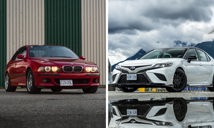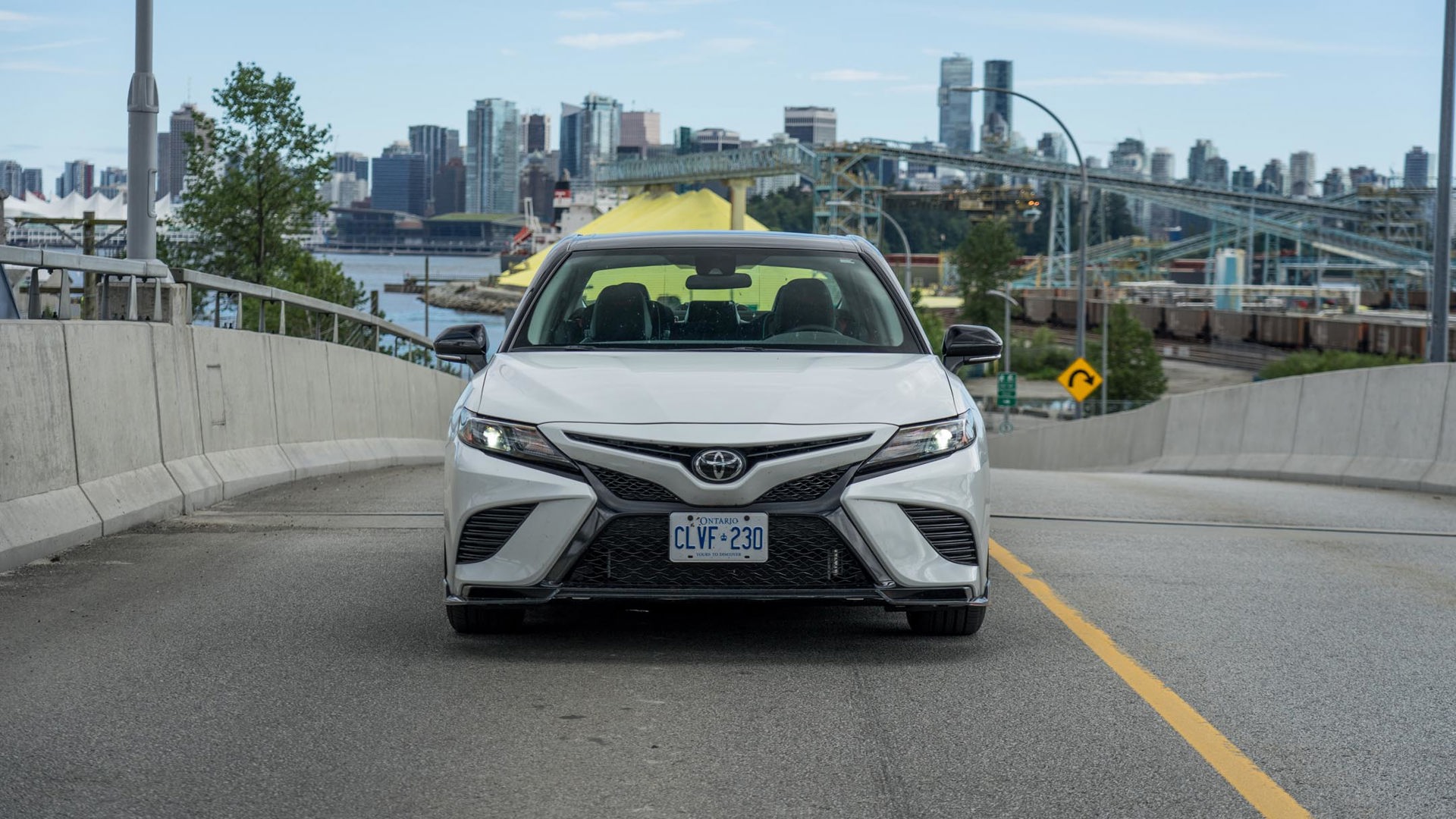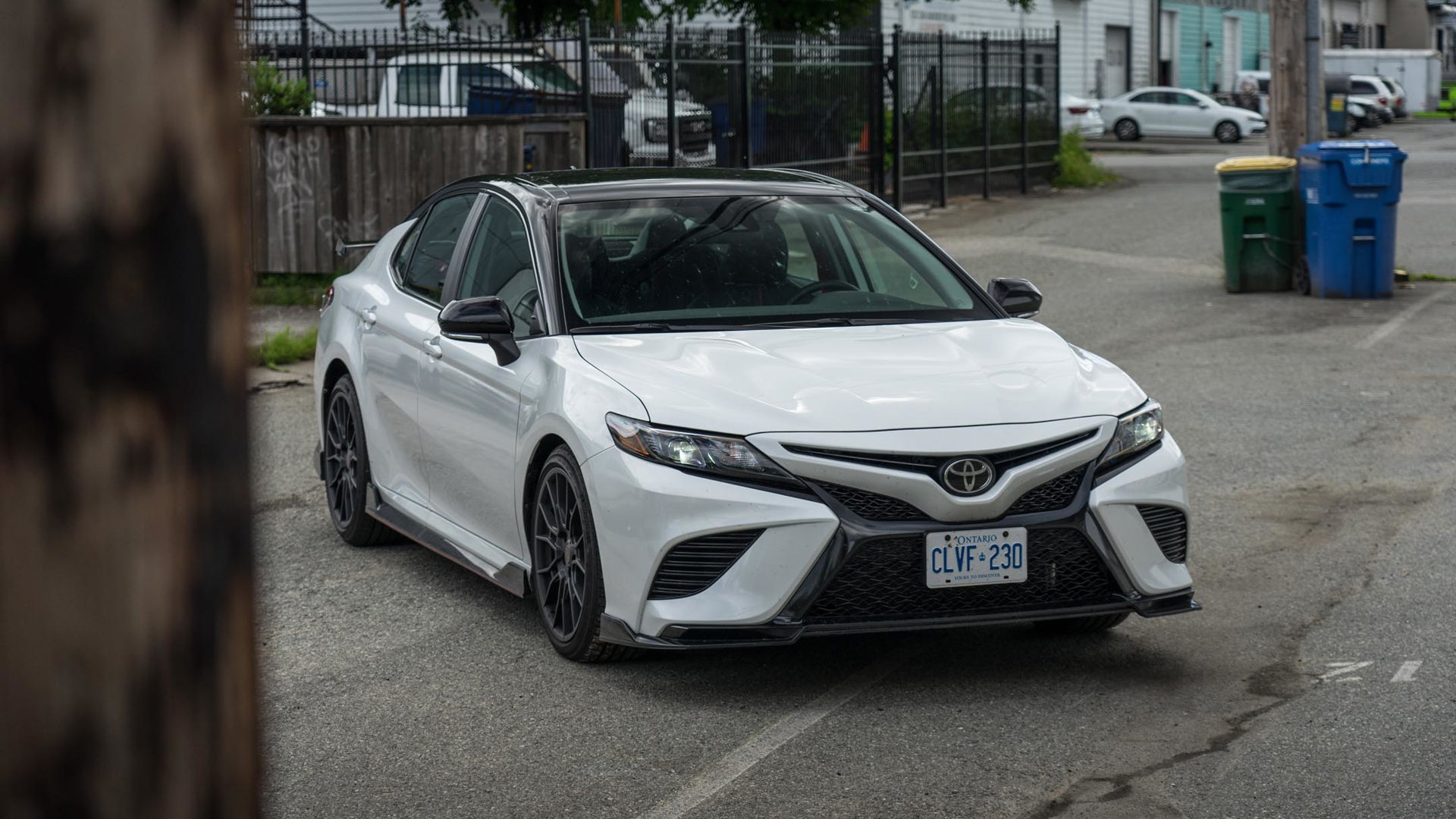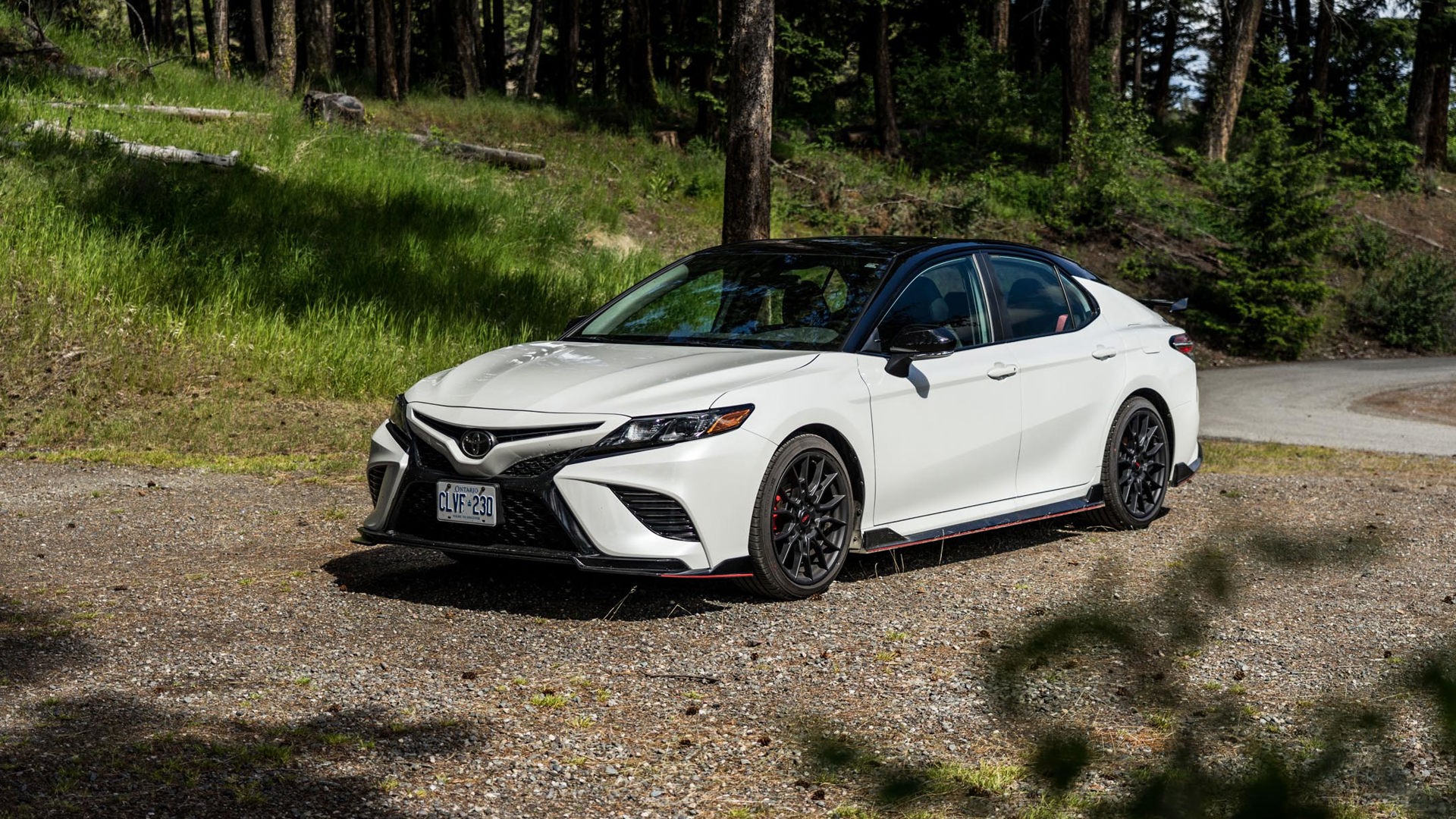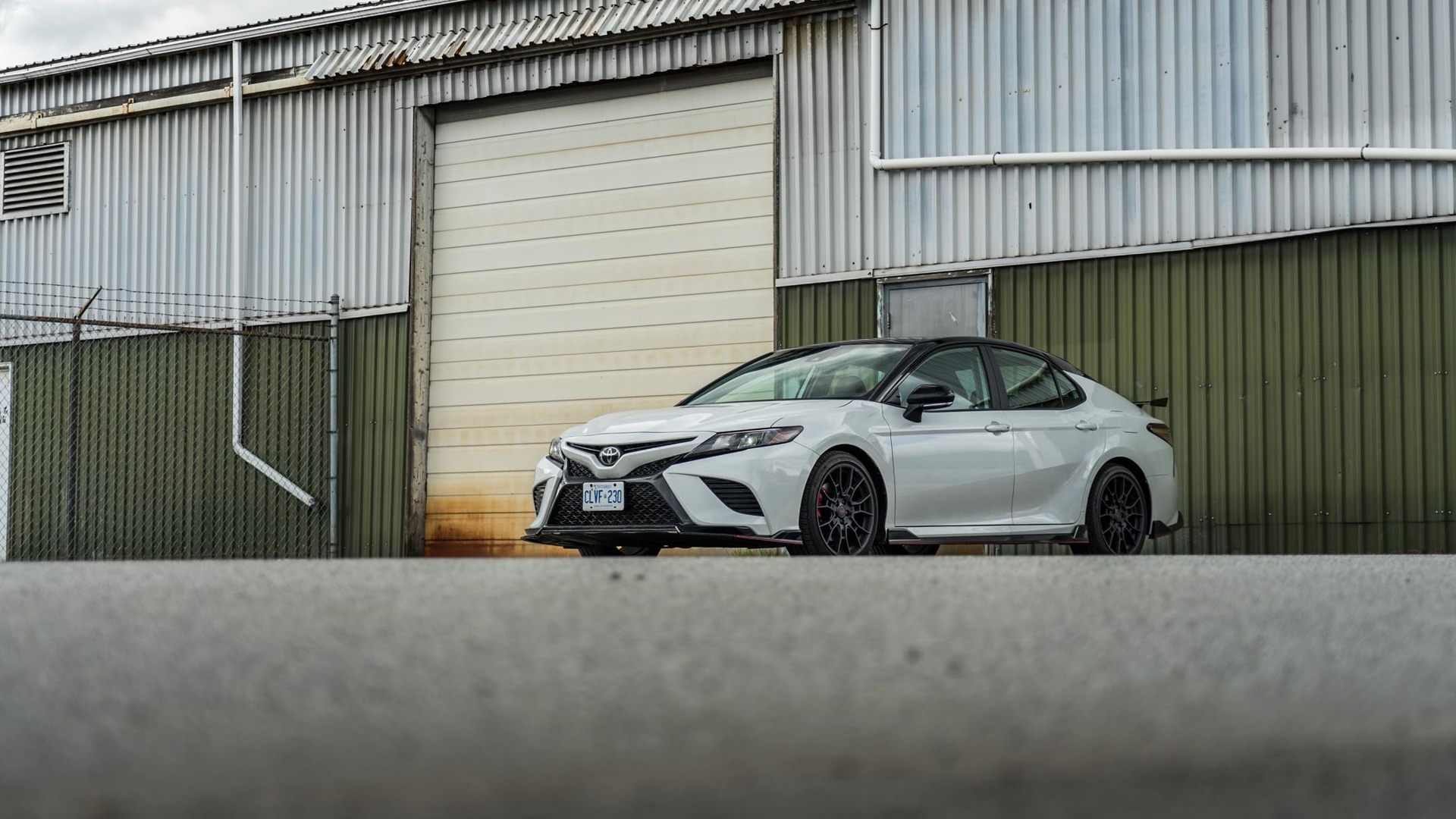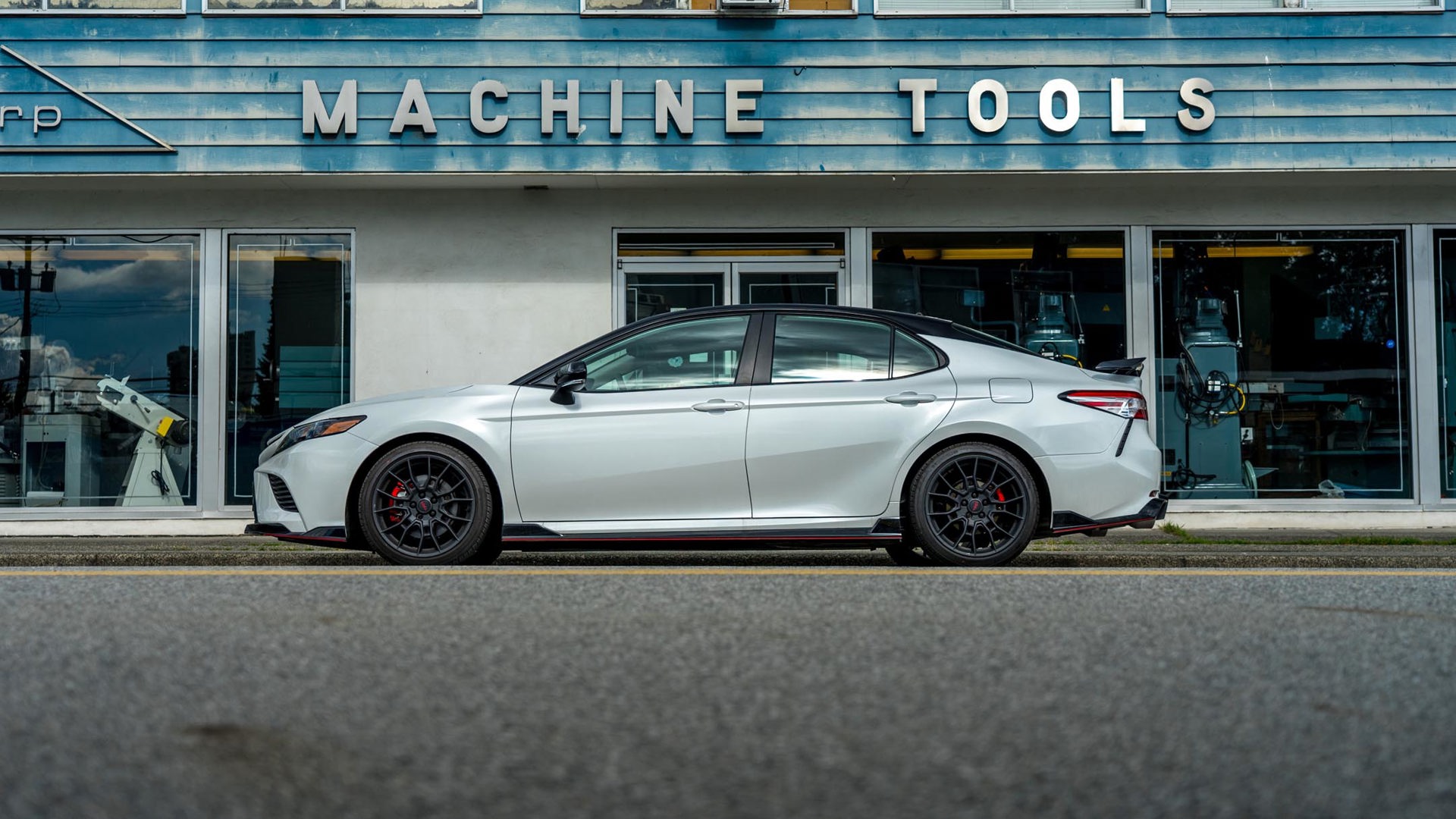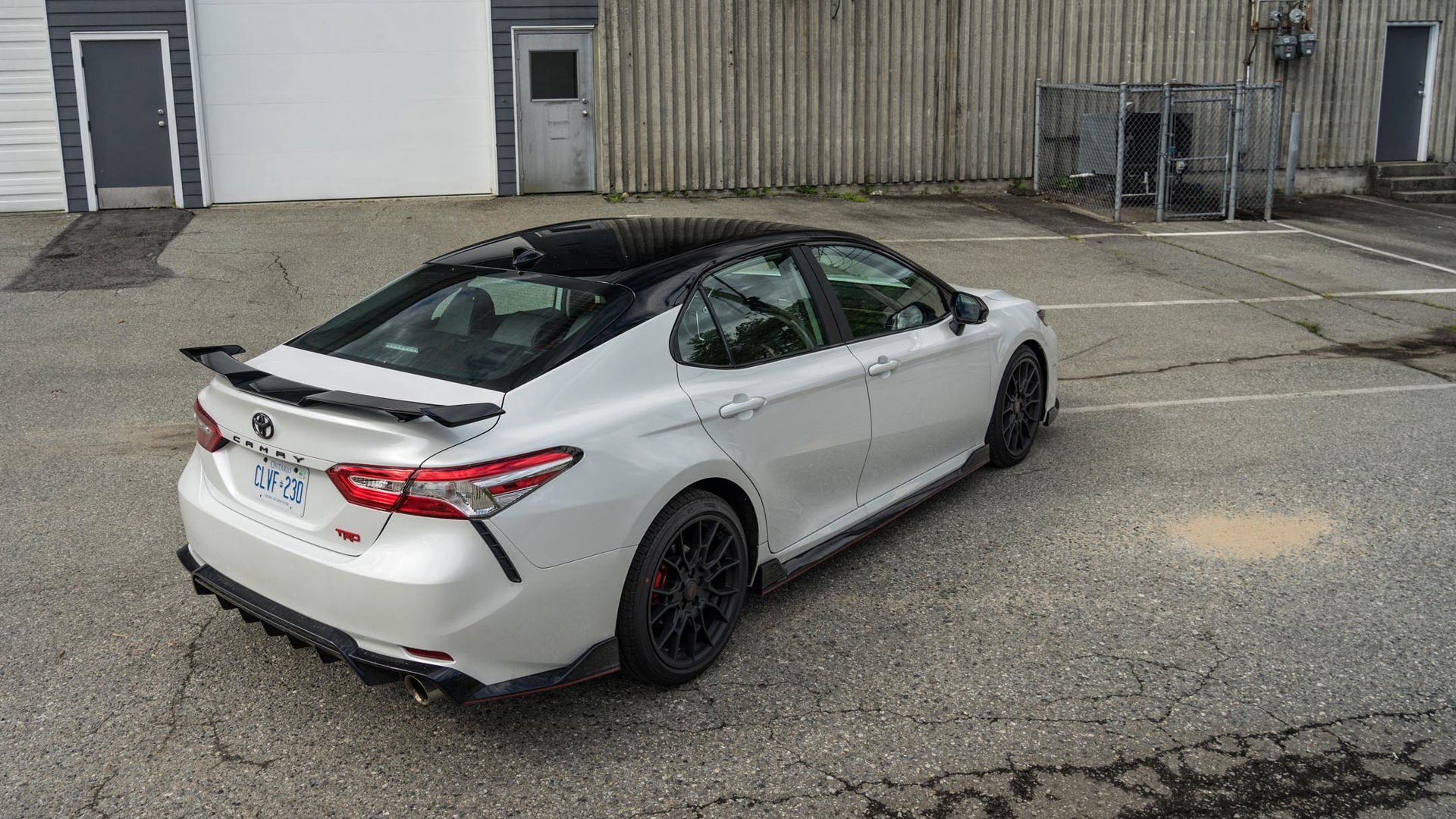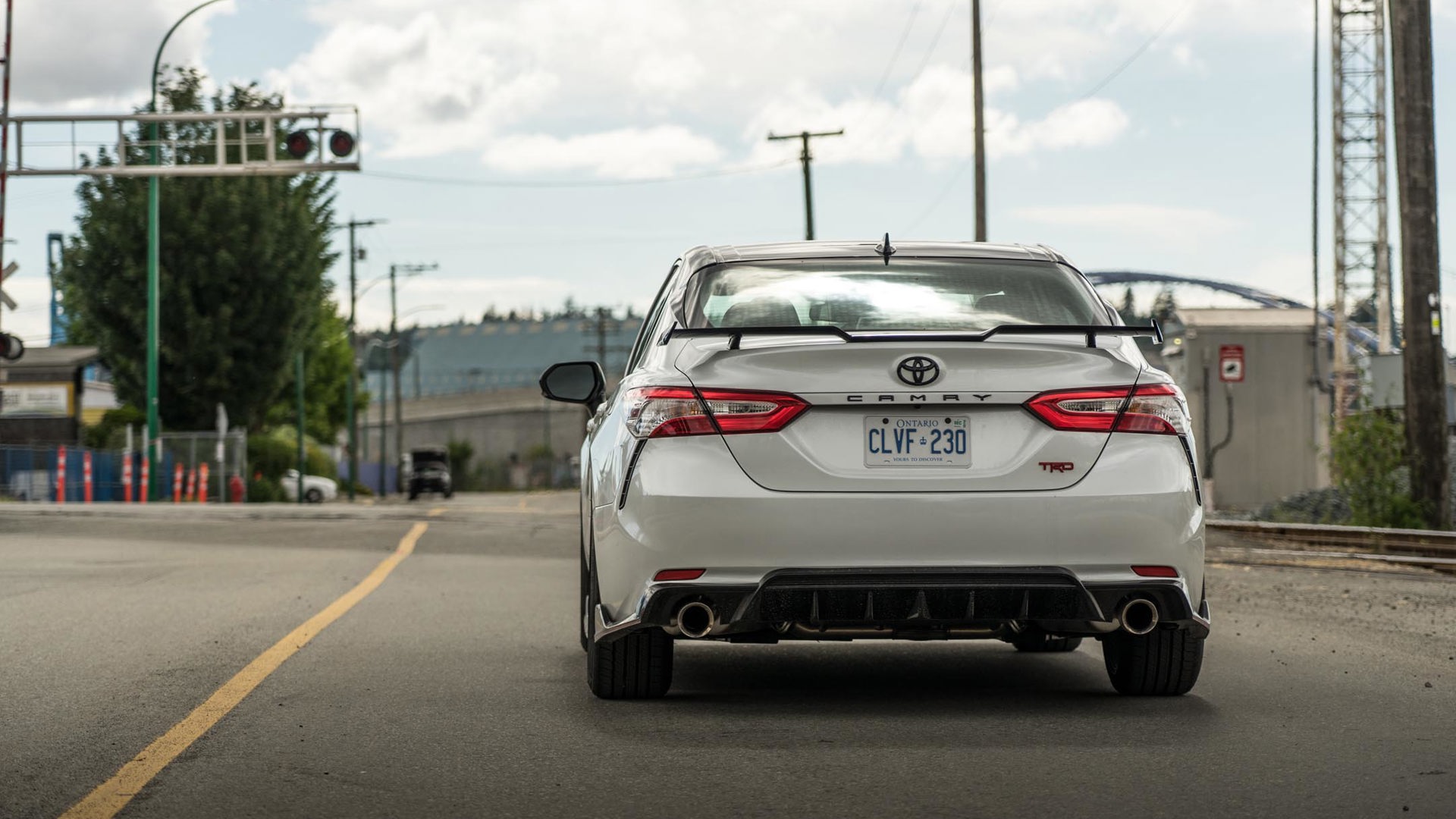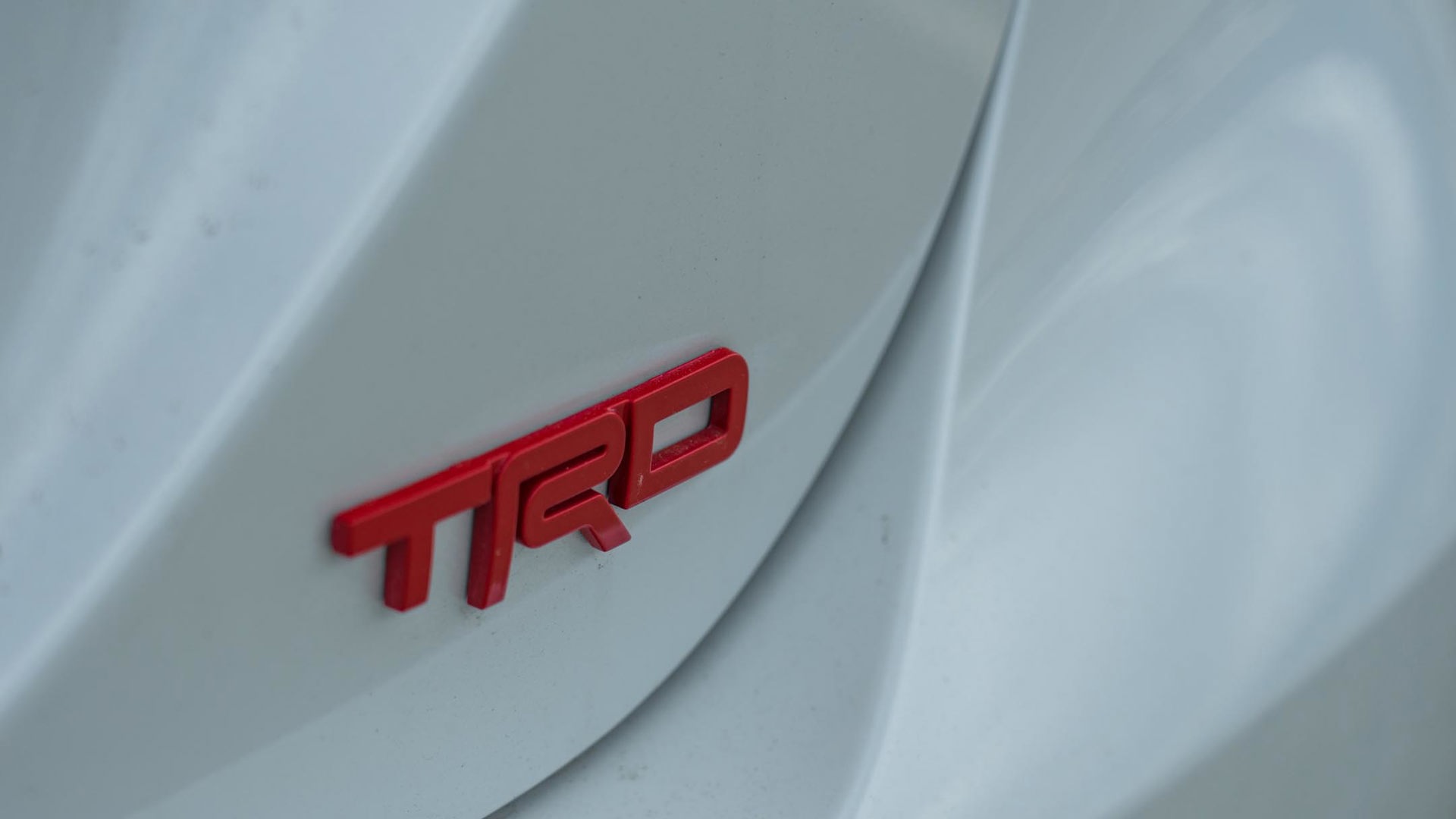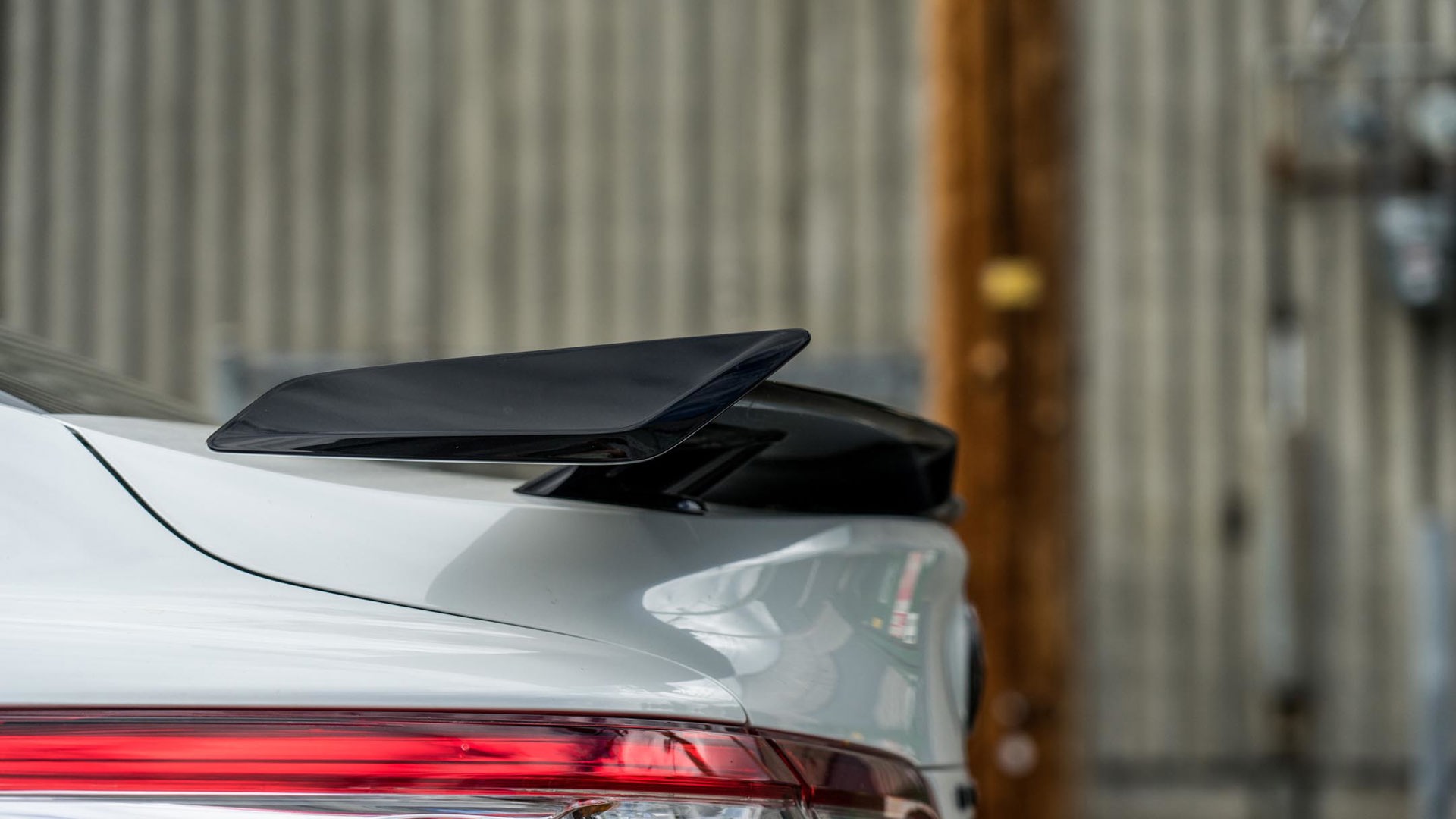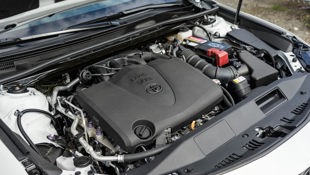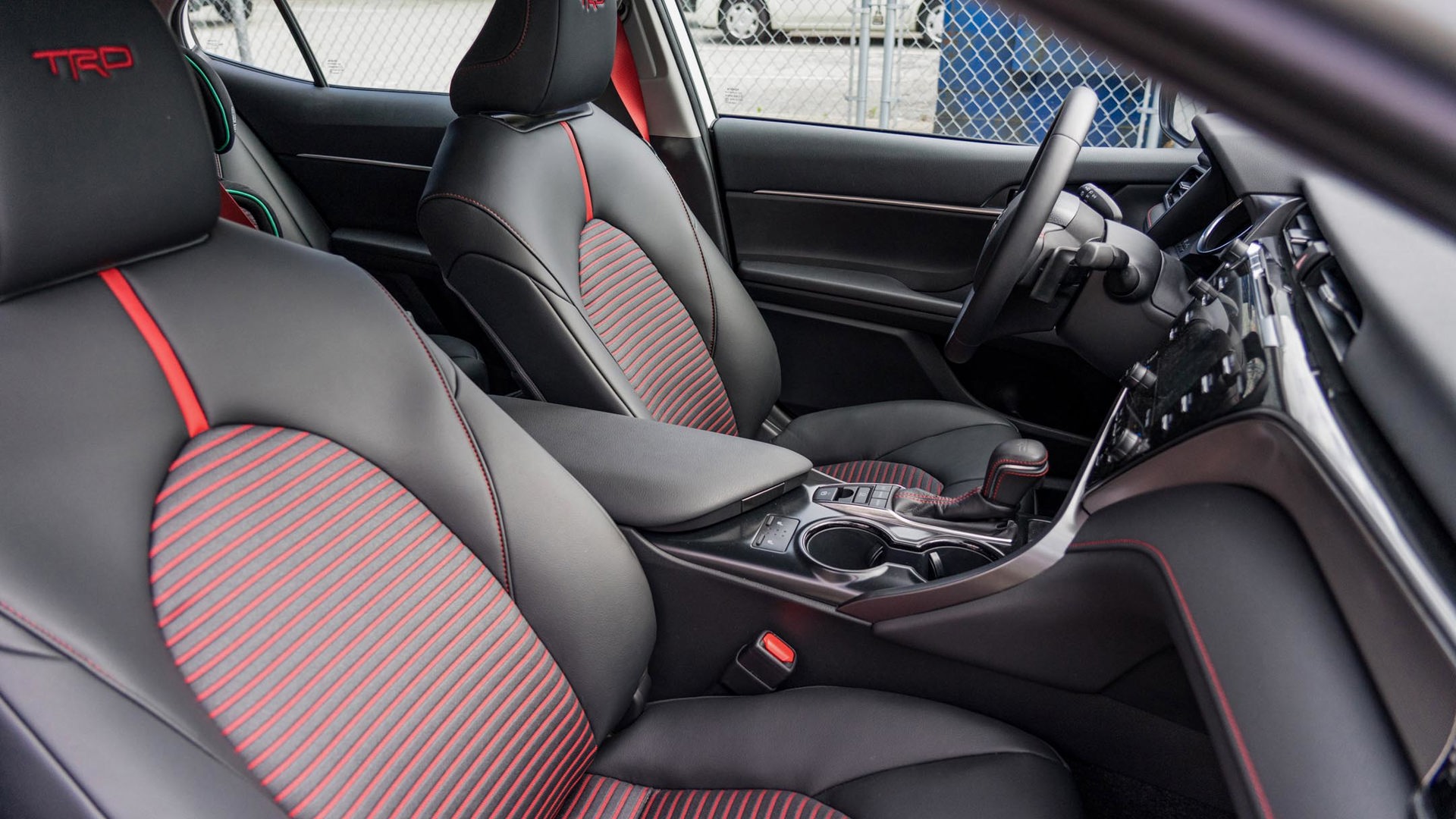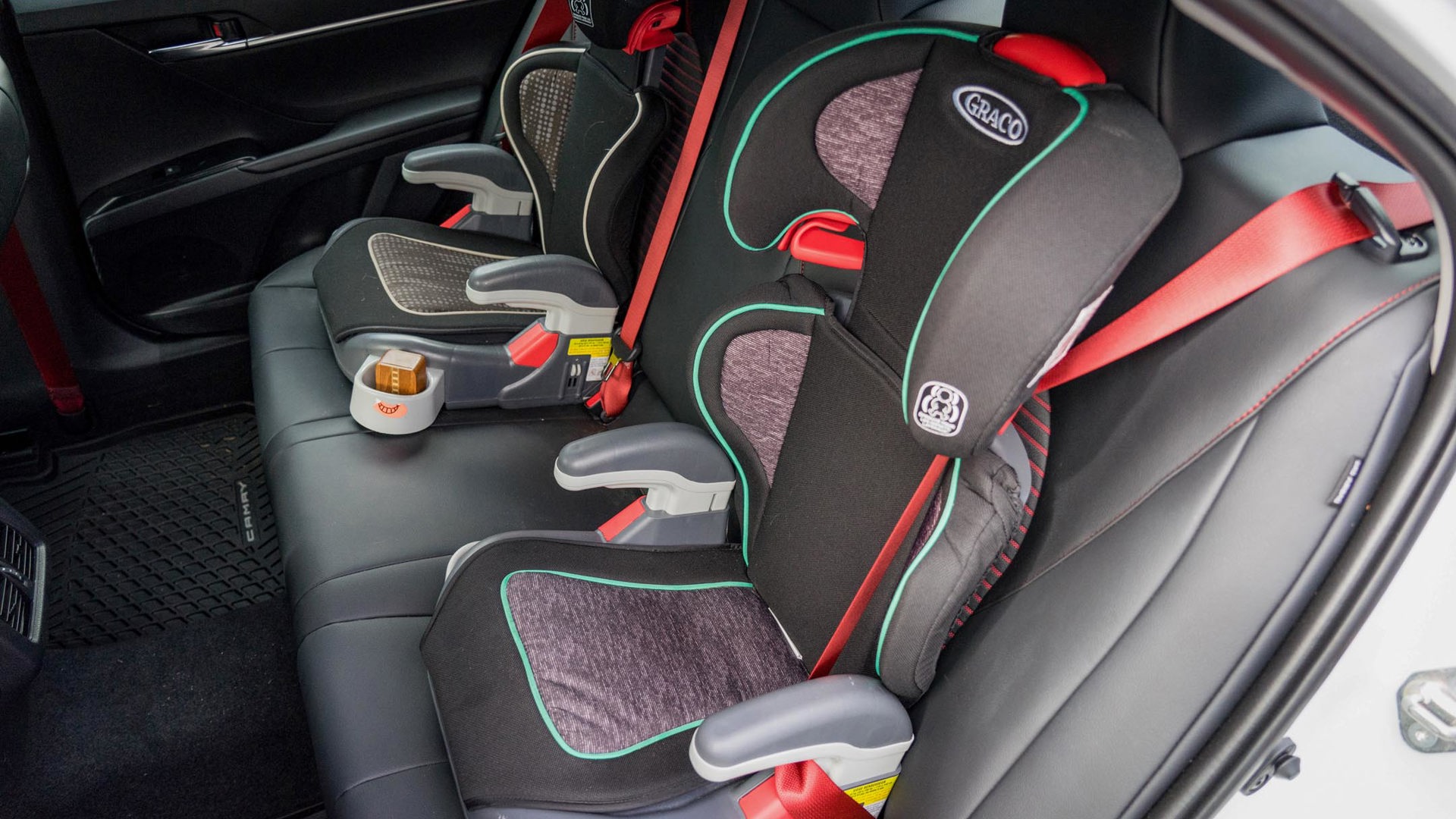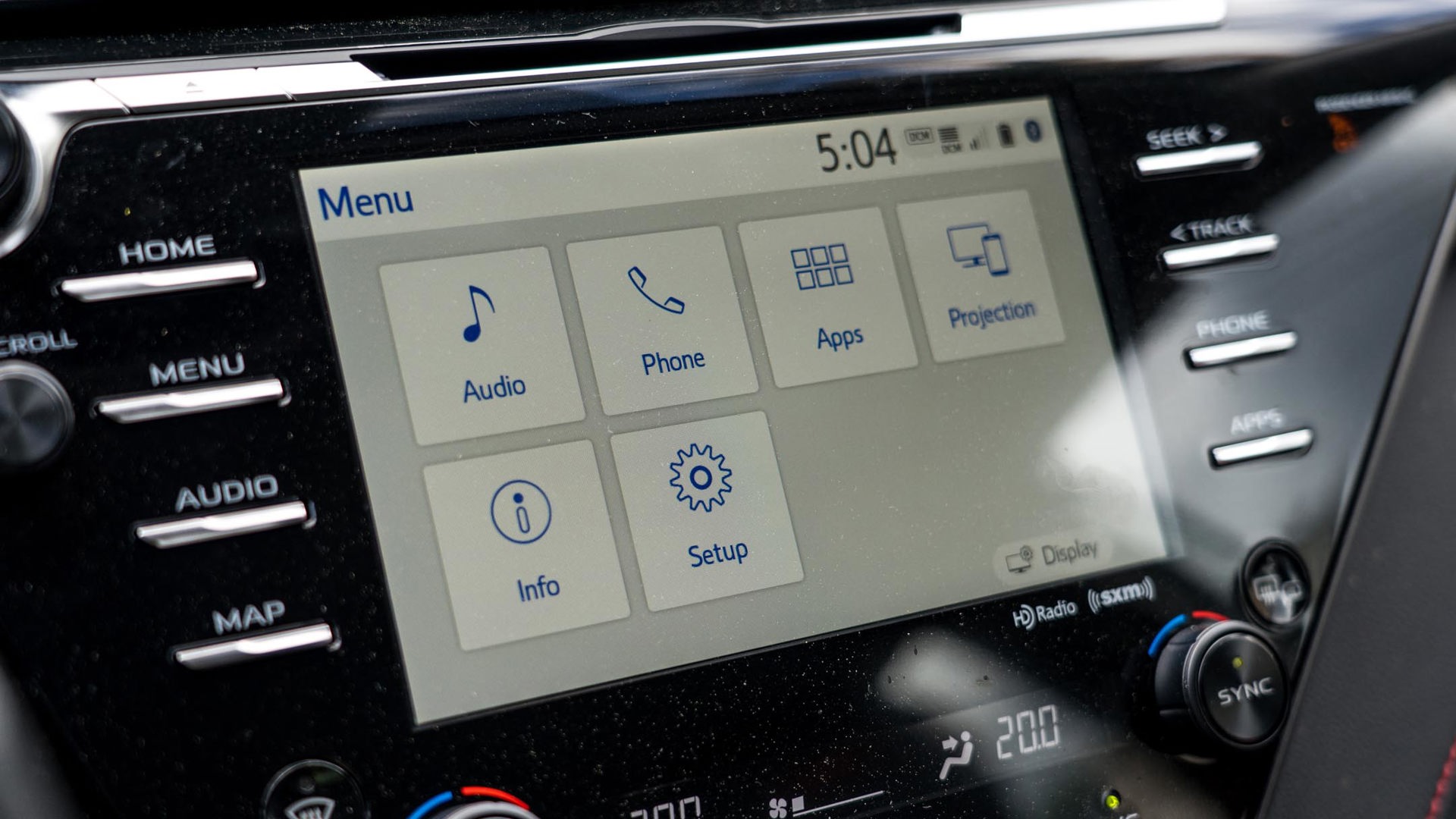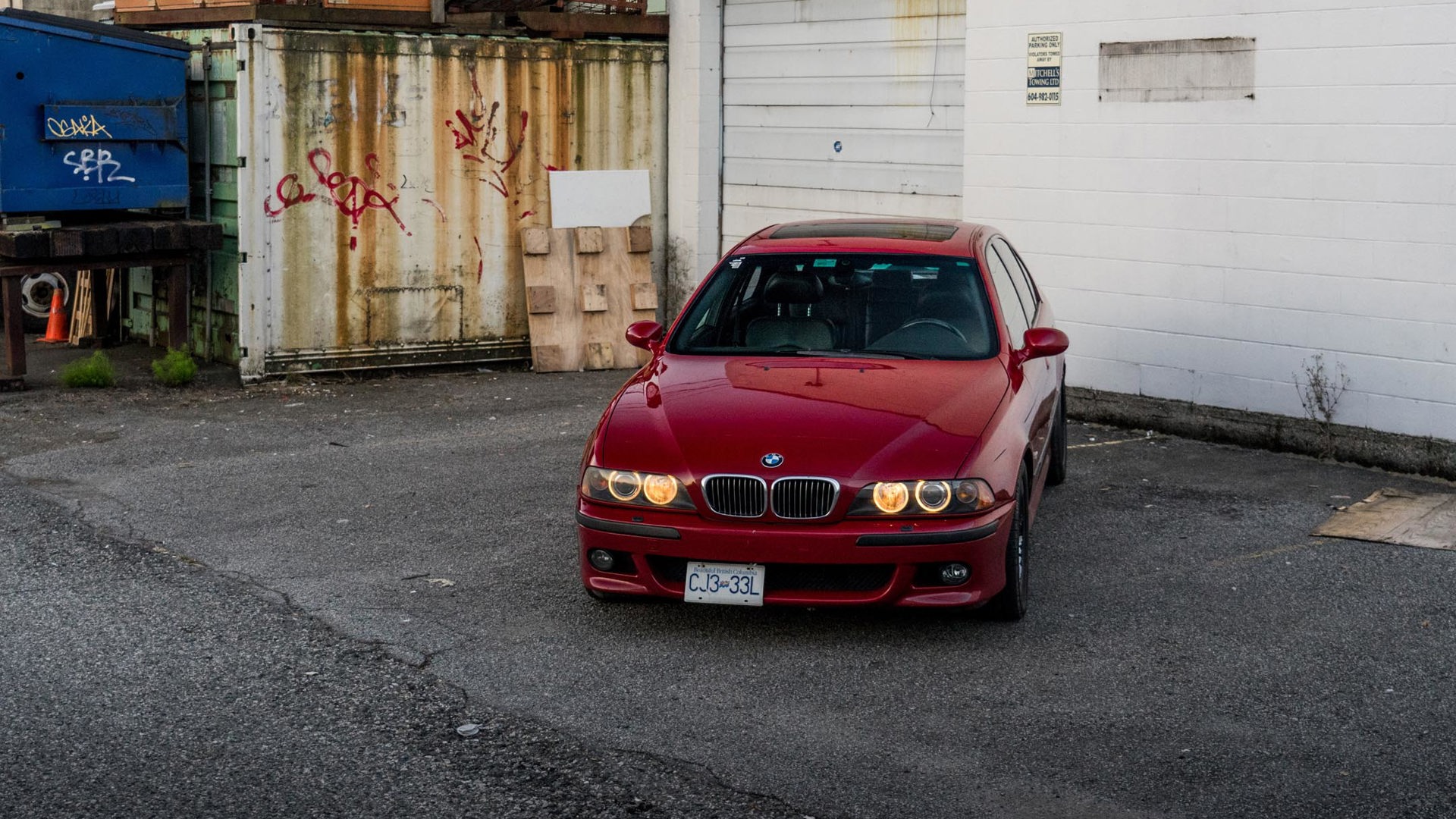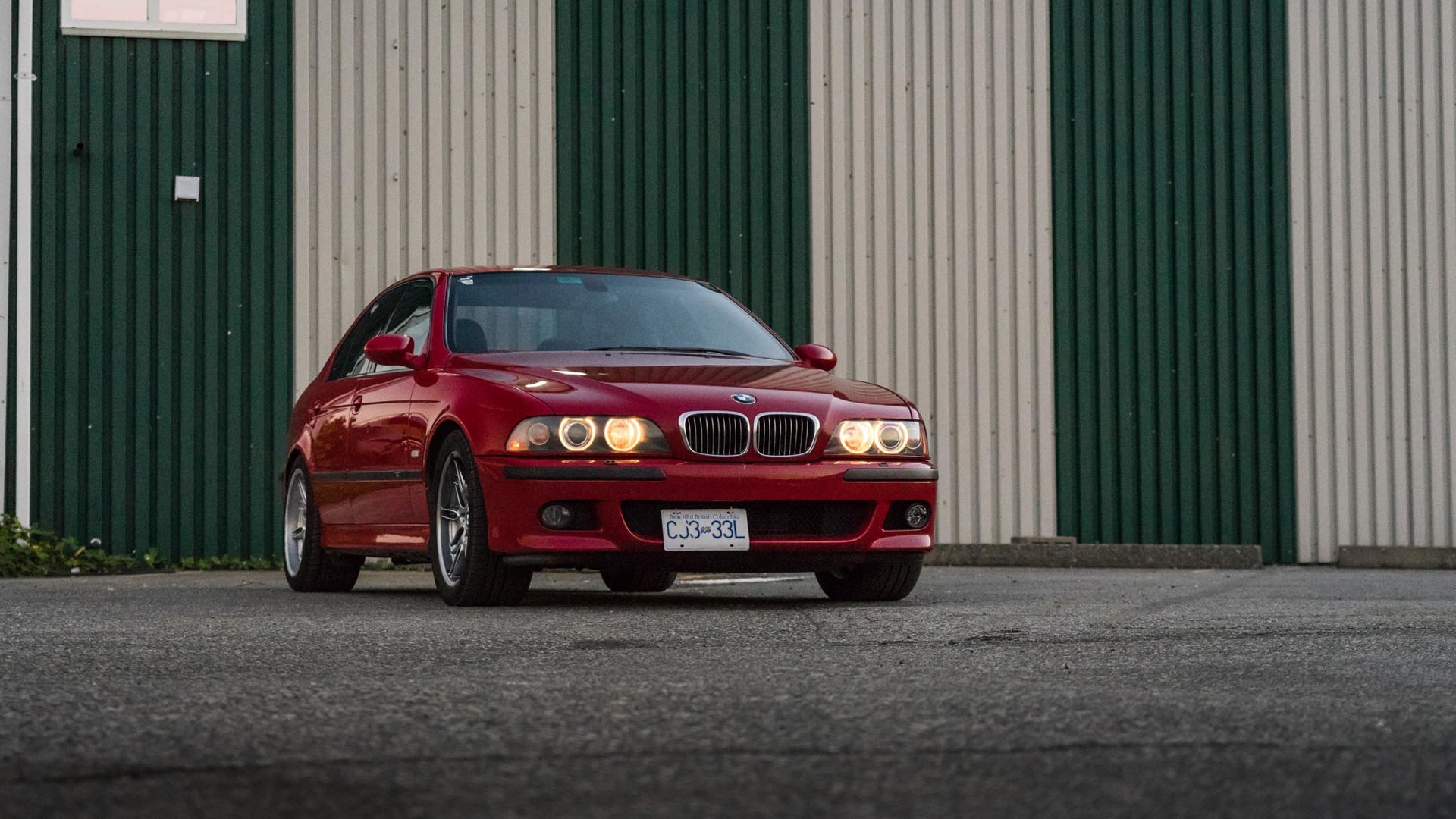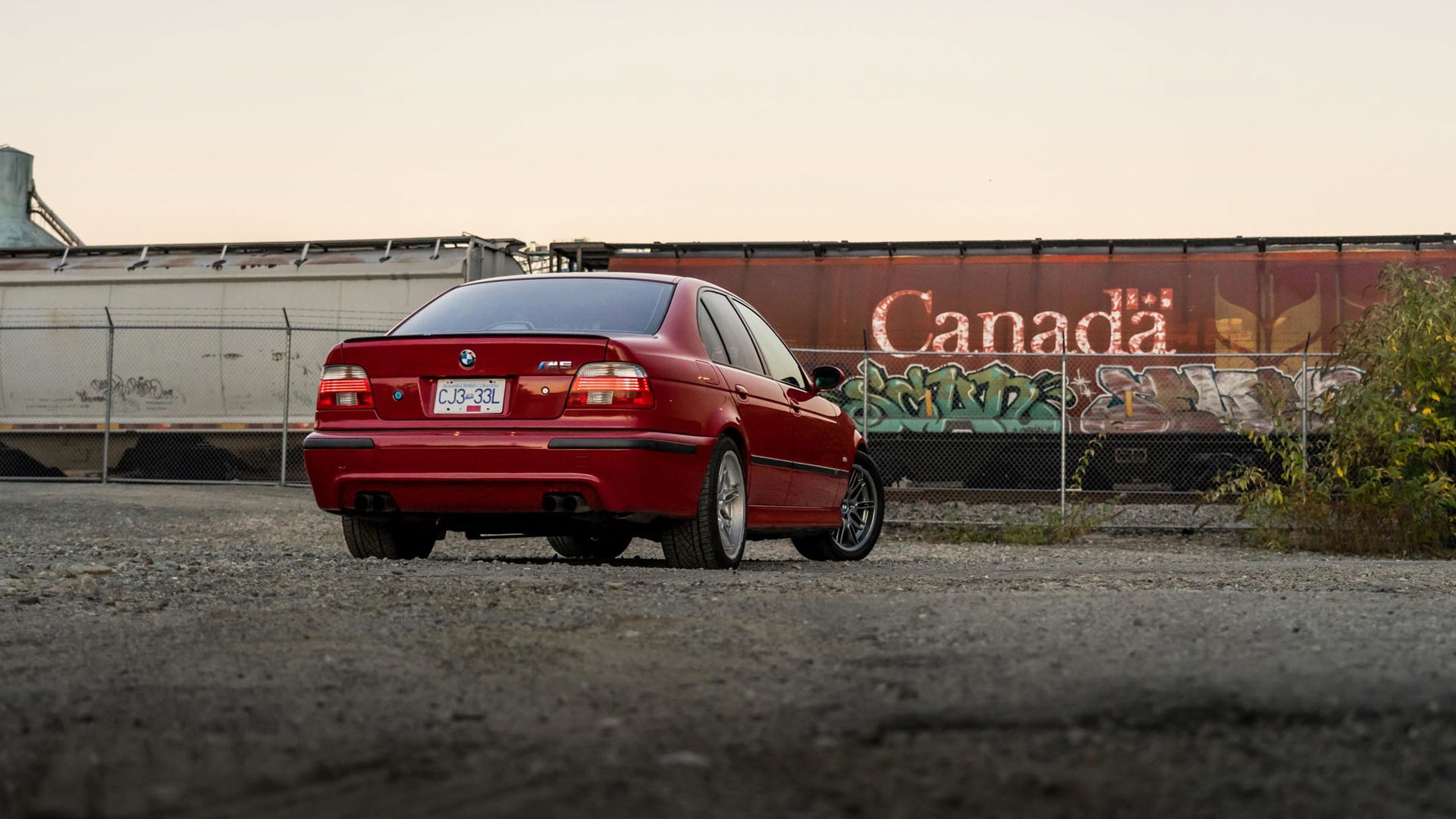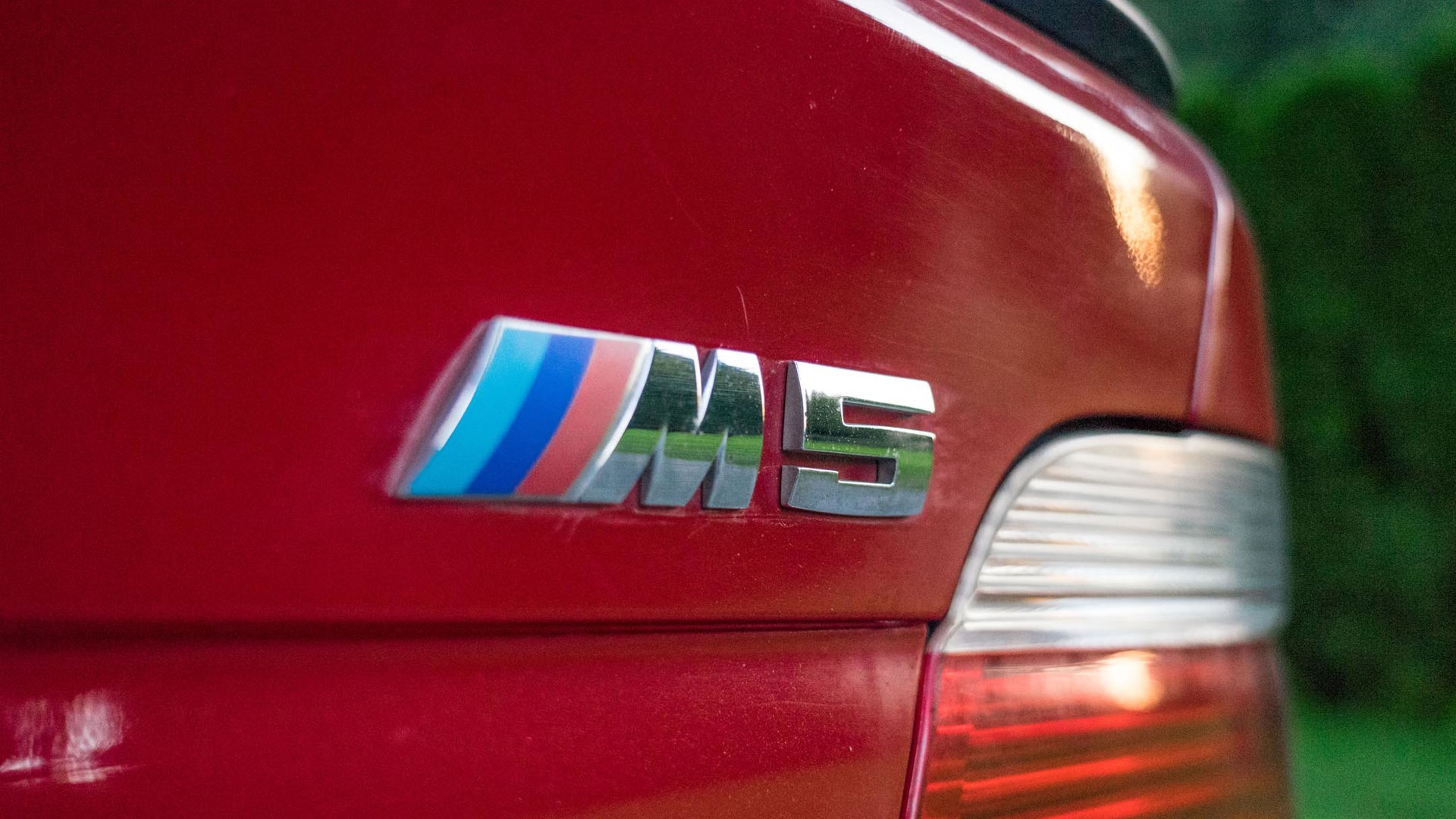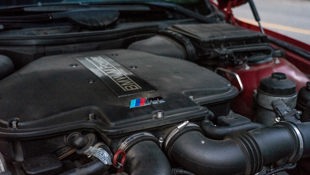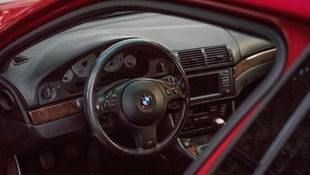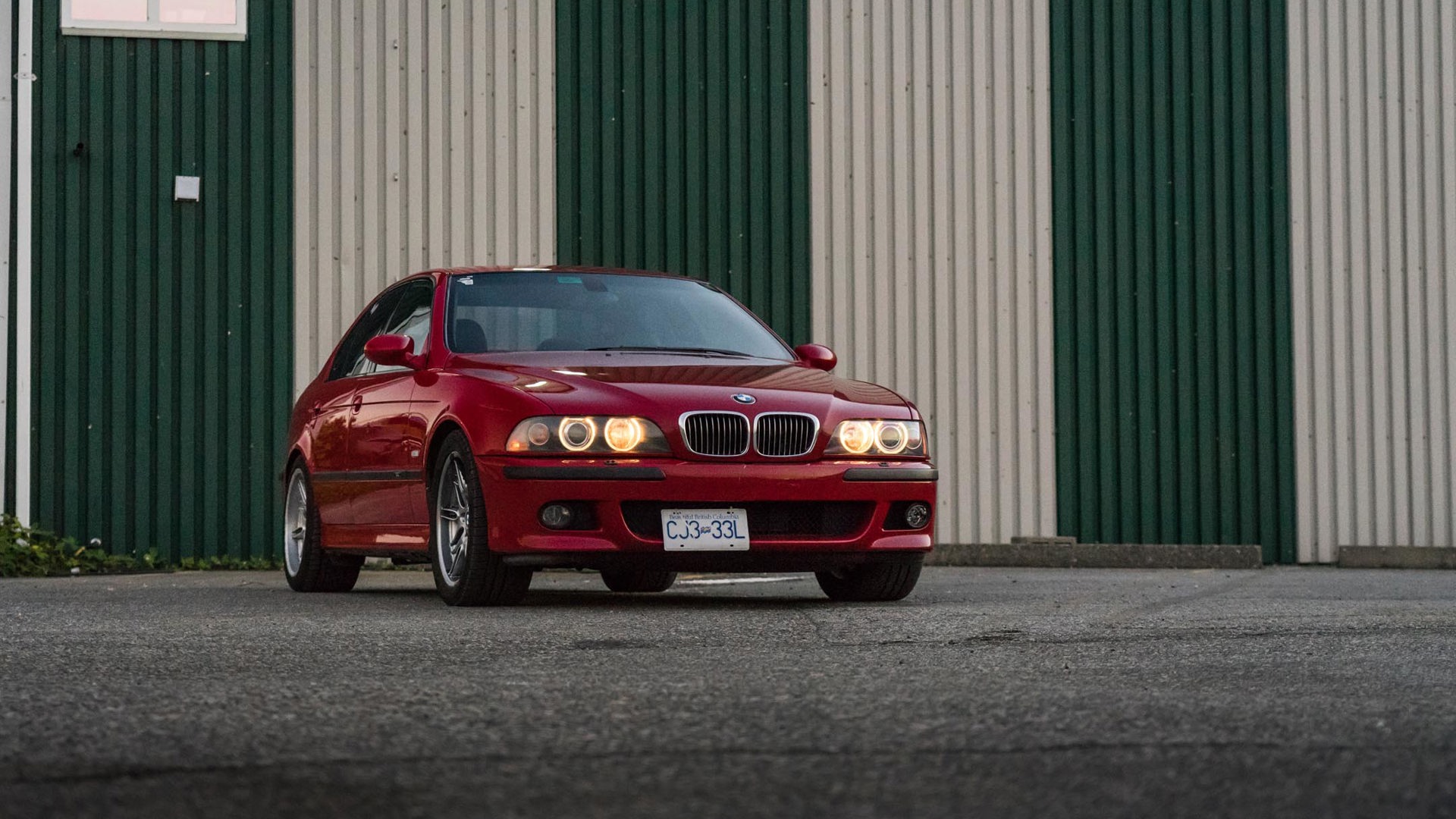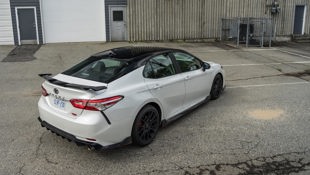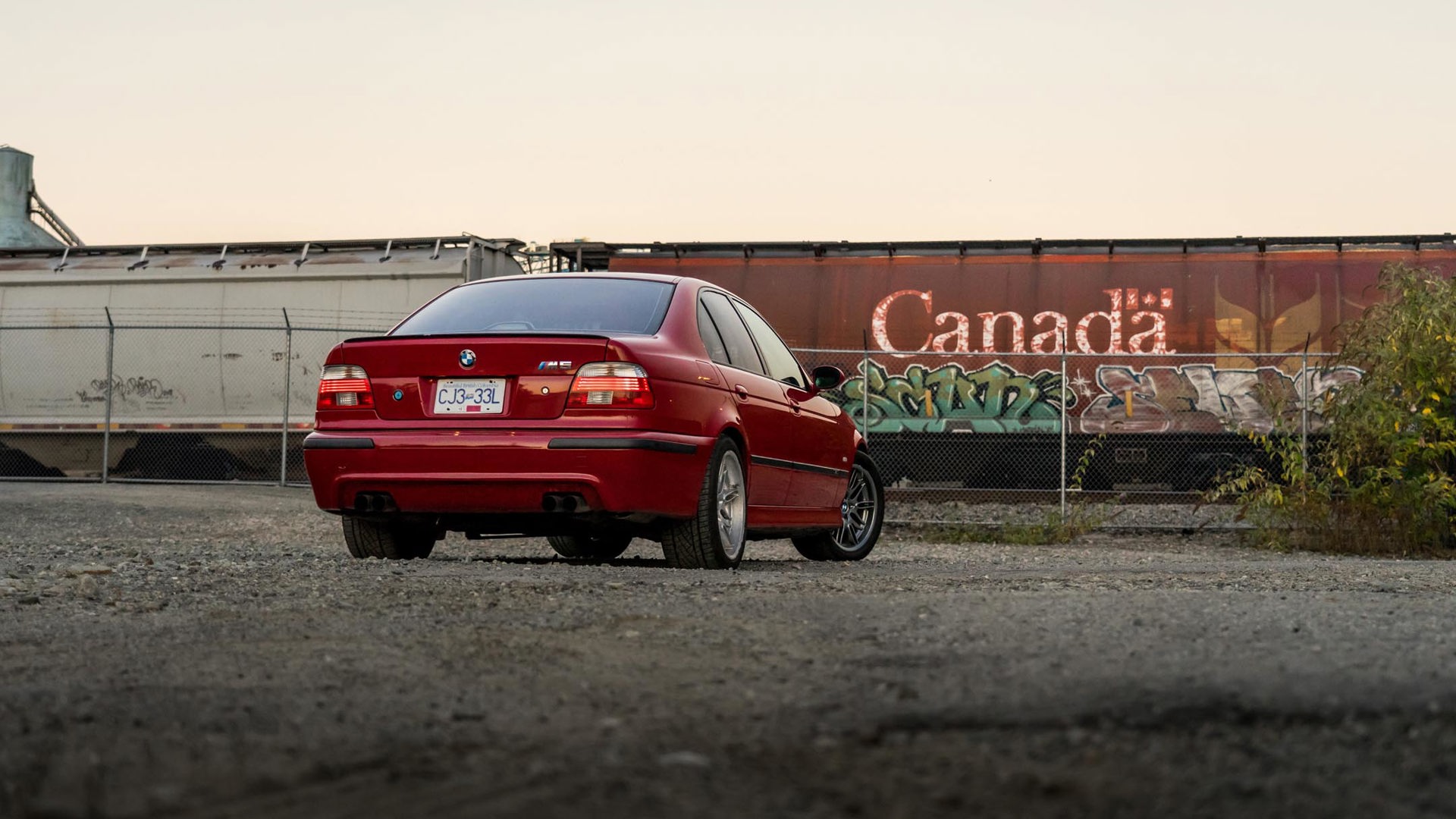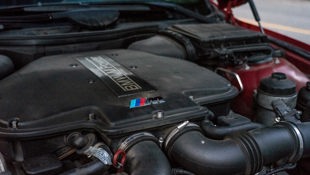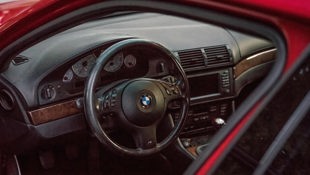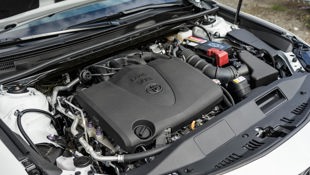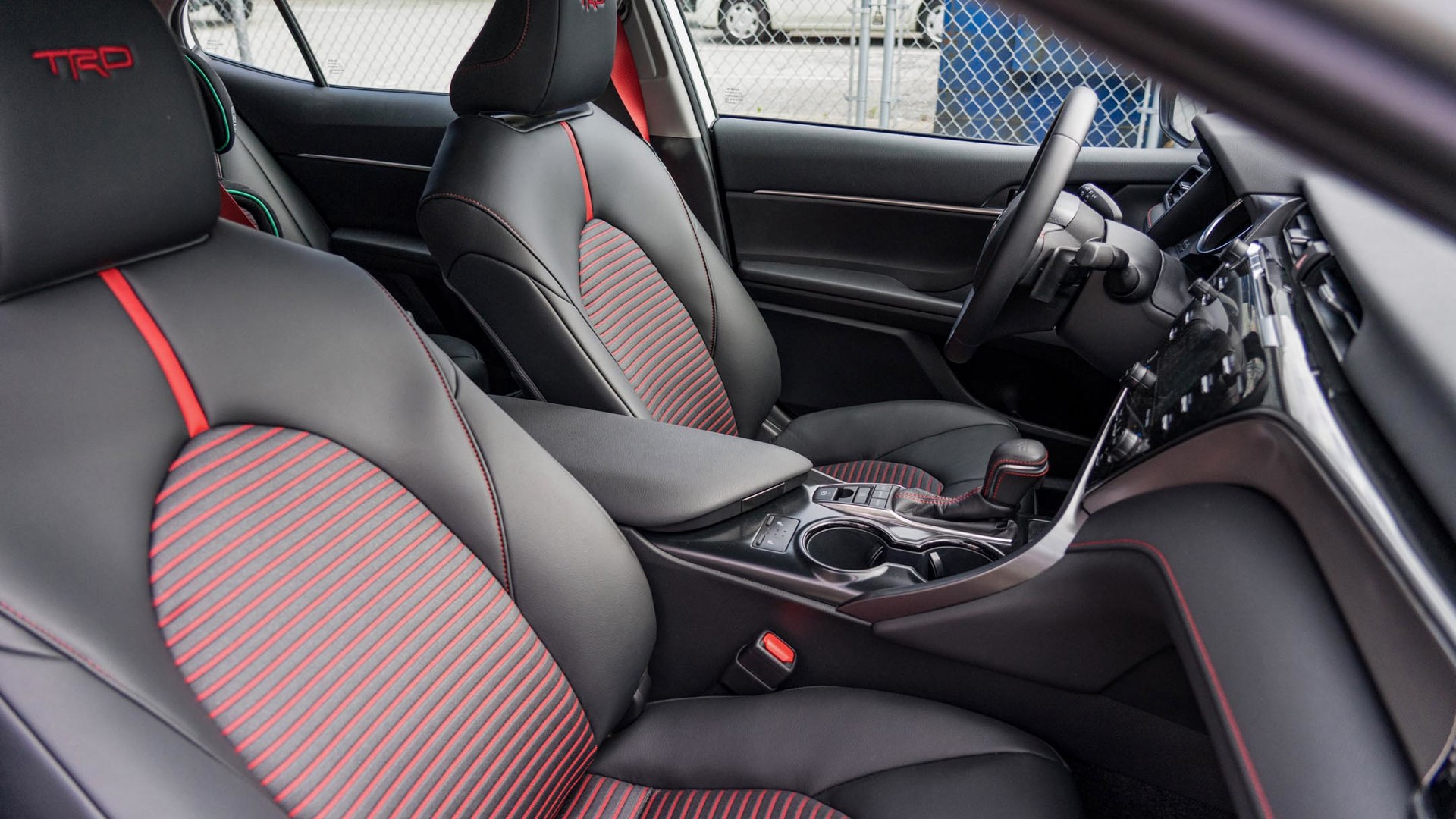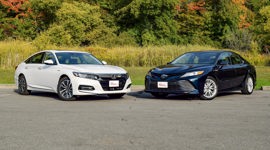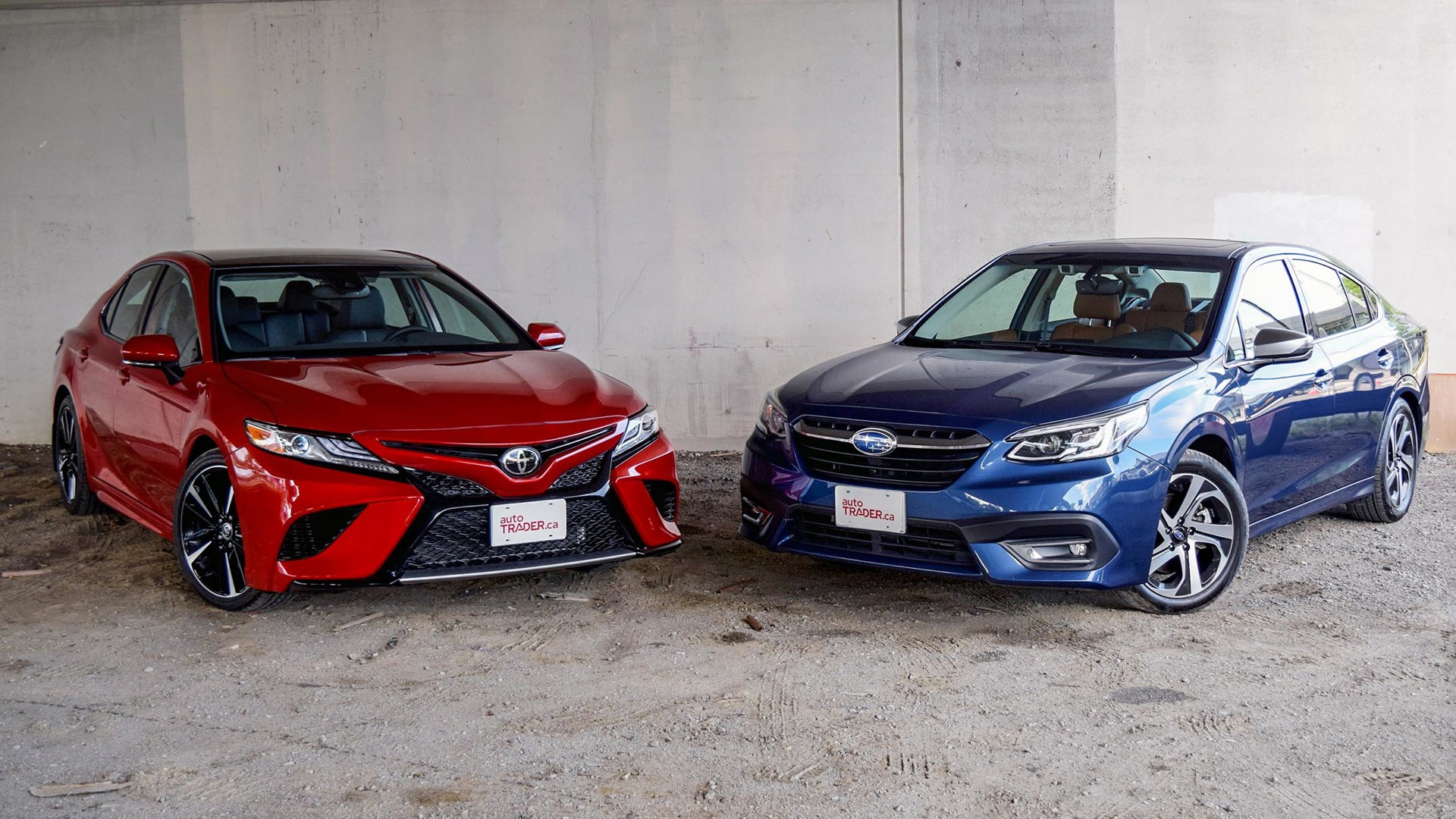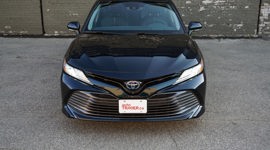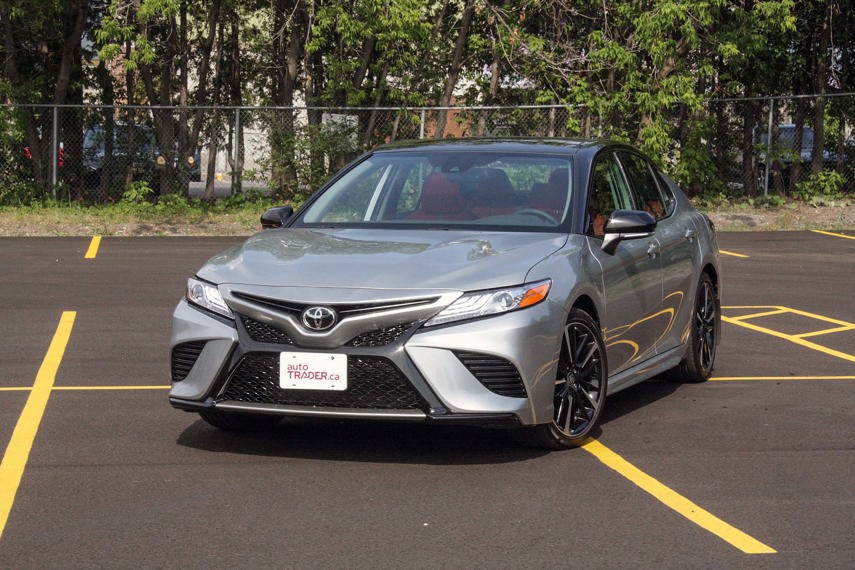Comparison Data
|
2020 Toyota Camry TRD
|
2001 BMW M5
|
|---|---|
|
Engine Displacement
3.5L
|
4.9L
|
|
Engine Cylinders
V6
|
V8
|
|
Peak Horsepower
301 hp @ 6,600 rpm
|
396 hp @ 6,600 rpm
|
|
Peak Torque
267 lb-ft @ 4,700 rpm
|
369 lb-ft @ 3,800 rpm
|
|
Fuel Economy
10.8 / 7.6 / 9.4 L/100 km cty/hwy/cmb
|
19.4 / 12.3 / 16.2 L/100 km cty/hwy/cmb
|
|
Cargo Space
428 L
|
459 L
|
|
Base Price
$35,990
|
$104,250 (new)
|
|
A/C Tax
$100
|
n/a
|
|
Destination Fee
$1,770
|
n/a
|
|
Price as Tested
$38,655
|
$104,250
|
|
Optional Equipment
$795 – Wind Chill Pearl Paint w/ Black Roof, $795
|
None
|
Before we begin, no, you can’t walk into your local BMW dealership and pick up a brand-new 2001 M5. More’s the pity.
Known as the E39 to BMW fans, the 1998–2003 generation of the M5 is generally considered to be the best one produced by the company, and thus the best midsize sport sedan ever made (there are all sorts of fun enthusiast arguments to be made here in favour of other contenders, but the E39 M5 tends to win the popular vote).
That a Toyota Camry would even be mentioned in the same sentence as an M5 seems faintly ludicrous, if not outright blasphemous. Certainly in 2001, the average BMW driver would have only noticed a Camry if its owner was hogging the left lane, or had just carelessly opened a door in a parking lot, chipping the M5’s bright Imola Red paint job.
However, in 2020, there’s no missing this Camry. As one of the last midsize sedans to offer a proper V6 engine, the Camry is an unlikely sporting hero, front-drive or no, and this is its most aggressive variant, done up in Toyota Racing Development (TRD) guise. So, a non-traditional comparison then: BMW’s legend versus one wild Toyota.
Styling
Once upon a time, buying a BMW meant that you were provided the elegance of a well-tailored suit. The company’s current cars have more grilles than the Home Depot’s outdoor living section, and have exchanged subtlety for pure aggression. Looking at the M5’s discreet exterior, you can’t help but think that modern BMW has made a fool’s bargain.
Stepping over to the Toyota, we find a machine that looks like the scene of a collision between two Honda Civic Type R hatchbacks. Remember when Camrys were the sort of boring beige appliance you would buy with the same enthusiasm as getting a new toaster? Well, now that toaster has a bifurcated spoiler, ground effects, and a front fascia like a stormtrooper’s helmet.
It’s pure Dad Vader. Having said that, the 19-inch wheels are among the best-looking I’ve seen on a Toyota, and making a Camry actually look interesting must have been a tough assignment. Add in the fact that every other car in traffic looks like a cross between the business end of a hairdryer and an origami basketball shoe, and I’m tempted to forgive this TRD version its excesses.
Toyota Camry TRD: 7.5/10; BMW M5: 9/10
Safety
Being a relatively modern car, the M5 is better than the usual “well, at least it has seatbelts” classic car experience. It comes with traction control and a sturdy body structure, and useful safety features you don’t often think about like excellent headlights.
However, if you had to choose a car to be a crash test dummy in, you’d be reckless not to go with the Camry. Besides a modern chassis, the Toyota gets a full suite of driver assists, including blind-spot monitoring, forward collision mitigation, and automatic headlights.
Toyota Camry TRD: 9/10; BMW M5: 6/10
Features
As an executive-class sport sedan, the M5 comes with high-grade leather, a stereo that was decent for its time, power memory seats, a CD player, and not too much else. You can’t connect your phone to it, but you won’t really want to anyway – more on that later.
The Camry, of course, is a modern midsize sedan. Thus, simply to be competitive with contemporary rivals, it comes with Android Auto and Apple CarPlay, dual-zone automatic climate control, an eight-inch touchscreen, and even wireless charging for your phone, the latter of which is sent to the scrap bin with the TRD pack. Twenty years of technology makes a world of difference.
Toyota Camry TRD: 8/10; BMW M5: 5/10
User Friendliness
BMW M5: What? I have to change gears manually? What manner of caveman technology is this?
Camry: It’s a Camry.
In all seriousness, the M5 would work perfectly well as a daily driver, as it has a small footprint and clear sightlines. The Camry has a slight all-weather advantage as a front-wheel-drive car, and is perhaps a bit friendlier to live with in traffic, thanks to its automatic transmission and simple infotainment controls.
Toyota Camry TRD: 8/10; BMW M5: 7/10
Practicality
Both of these machines are sensible four-door sedans with roomy trunks. Twenty years ago, the M5 would have been practical enough as a family sedan, and stepping up to an X5 would require serious thought. However, today, picking a sedan over a crossover is a deliberate choice at exchanging some cargo-carrying capacity for fun.
Likewise, getting a Camry instead of a RAV4 is a decision that most families no longer make. Viewed in that light, the Camry TRD makes a bit more sense. If you’re going to go for a Toyota sedan instead of a crossover, why not go all out?
By the numbers, the Camry has 428 L of cargo space, with the M5’s trunk slightly bigger at 459 L. The Camry’s got the larger rear seat, but either makes a practical choice. The one asterisk is that the Camry TRD has rear bracing that stops the rear seat from folding.
Toyota Camry TRD: 6.5/10; BMW M5: 7/10
Comfort
Ordinarily, the Camry would be the obvious winner here, as the regular versions are like sitting in a bowl of oatmeal. But the TRD upgrades aren’t limited to spoilers and big wheels. Fitted with a lower and stiffer suspension, the TRD is quite jouncy over broken pavement, with a ride quality that’s more akin to a hot hatchback than your average midsize sedan.
This characteristic highlights one large disappointment about the Toyota’s interior: the seats have been picked out in bright red accents – it slightly resembles a Canadian Tire upgrade, to be blunt – but they don’t offer really any more lateral support than the standard Camry seats. Since the suspension is tauter, couldn’t TRD have firmed the seats up, too?
The M5 is a heavy car, and it feels it. This thing was meant to be rock solid on smooth Autobahn asphalt, and the suspension can sometimes be upset by rough pavement transitions. However, it’s not uncomfortable, and is, if anything, smoother-riding than some modern, big-wheeled BMWs.
Toyota Camry TRD: 7/10; BMW M5: 8/10
Power
If you’ve skipped ahead and scrolled directly here, then welcome to The Good Stuff. First, the M5.
BMW stands for Bayerische Motoren Werke – the company literally has motor as its middle name. The M5’s 4.9L V8 was a masterpiece at the time, making 396 hp at 6,600 rpm and a peak 369 lb-ft of torque at 3,800 rpm. Redline is 7,000 rpm, but never mind all these numbers, because the sound this thing makes is pure eight-cylinder fury. Married to a six-speed manual, the M5’s heart is a real meet-your-heroes moment. If you can afford one, stop reading and go purchase one immediately.
The Camry’s V6 powerplant is down two cylinders and nearly a hundred horsepower versus the M5, and in fact does not produce any more power than the standard Camry V6. Despite the shiny exhaust pipes, Toyota didn’t seem interested in eking out any additional power from its steadfast 3.5L six-cylinder. Here, it makes 301 hp at 6,600 rpm and 267 lb-ft of torque at 4,700 rpm.
But again, don’t let the numbers tell the whole story here. The Camry doesn’t have the most impressive 0–100km/h times or drag racing slips, but it does have genuinely impressive passing acceleration, and that V6 sounds pretty good at a howl. Further – and please don’t actually do this – it’ll put up with the kind of owner that changes the oil once a year at best. A durable 300 hp is nothing to sneeze at, and the eight-speed transmission performs snappily when called upon.
Toyota Camry TRD: 7/10; BMW M5: 9/10
Driving Feel
Thus far, the TRD has only chalked up wins for attributes that nearly any modern sedan would have. It doesn’t do anything that can really match the M5 for that special feeling. That is, not until you put it into a corner.
Toyota’s performance engineers may not have touched the engine, but their fingerprints are all over the Camry TRD’s chassis. Stiffer springs and bigger anti-roll bars pair with chassis bracing and unique damping to produce a car that corners flat and handles fast transitions well. The TRD isn’t just quick for a Camry – it’s a genuine performer.
Add upgraded brakes and what had previously seemed like a mostly cosmetic package will widen your eyes. No, it’s not akin to the difference between a regular BMW 5 Series and an M5, but there’s more performance than you’d expect here. Even the steering feel is better than anticipated, and the total package is something that’d have you out hunting backroads.
In comparison, shockingly, the BMW shows its age here. Its powertrain can’t be matched, but neither can the M5 match the level of modern technology that’s gone into honing the Camry’s poise. No, it’s not a sentence I expected to find myself typing.
Still, even with a bit more body roll, the M5 feels as athletic as you hope it would. It remains a very special machine to drive, providing an experience that will please any diehard M5 fan. The Camry TRD is good enough that it might actually create some diehard Camry fans where none had existed previously.
Toyota Camry TRD: 9/10; BMW M5: 8/10
Fuel Economy
With a big V8 and a manual gearbox, the M5 was always going to be a thirsty choice. It’s not actually that bad for highway mileage, where it’s possible to see consumption dip below 10.0 L/100 km. Really, though, owning an older BMW is going to require deep pockets in terms of maintenance and potential repairs, so if fuel economy is a primary concern, steer clear.
As its V6 is no more stressed than a normal Camry’s, the TRD returns a stated 9.2 L/100 km in combined highway–city driving. Over the course of a week of mixed use, observed consumption was 10.2 L/100 km, which is pretty reasonable for a 300-hp sports sedan.
Toyota Camry TRD: 8/10; BMW M5: 6/10
Value
A used vehicle will always look like the value proposition on paper. But even a well-kept M5 is not without its foibles, particularly any plastic elements which can grow brittle with age. Basically, you’ll have to love your M5 and stay on top of its maintenance, and not mind the fact that the price you purchase it for is only the beginning. But it is a lovely machine.
The Camry TRD is actually a step down from the XSE V6, as you’re giving up a few niceties like the upgraded stereo and leather interior. At $36,785, plus an $1,770 freight charge, it’s roughly the same price as a well-equipped four-cylinder Camry, and for a rare model with one of the last V6s on offer, the TRD looks like strong performance value for your dollar. I’m not sure it’ll ever be as collectible as an M5, but it’s well priced.
Toyota Camry TRD: 8/10; BMW M5: 7/10
The Verdict
Let’s face it: only one of these cars is destined to become a legend. The M5 was never going to be knocked off its throne by a front-wheel-drive Toyota. Even a V8-powered Lexus GS F would have a hard time with BMW at its best. But in an age where crossovers rule the sales charts, the Camry TRD did come out of this comparison looking like something genuinely interesting to own and surprisingly good fun to drive. Since when was a Camry the daring choice? Since now.
